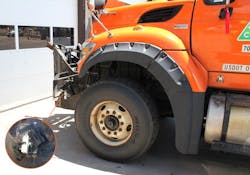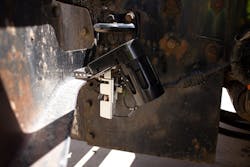How mobile sensing is changing the game in winter road maintenance
From the application of anti-icing chemicals and the spreading of salt to the removal of snow and ice, agencies responsible for road maintenance during the winter months face a number of unique challenges—and as weather becomes more severe, these issues are only getting worse.
Monitoring the current conditions on roadways is critical to performing winter maintenance operations that reduce the risks posed by hazardous driving conditions. Weather is responsible for more than 1.2 million crashes in the U.S. every year, and more than 70% of the nation’s roads are located in regions that receive more than 5 in. of average annual snowfall (and even more areas are at risk of ice storms). And because the majority of the country’s population lives in these wintry locales, winter road maintenance operations are critically important to our nation’s roadway safety and mobility.
Transportation managers and decision-makers at the city, county, and state level all require data pertaining to the environmental conditions impacting their roadways. Winter weather observation systems, such as road weather information systems (RWIS), help support that decision-making through the measurement of atmosphere and pavement conditions. However, because of their static locations, many are not able to provide a comprehensive picture of conditions along the road network during a storm or even keep up with new business or residential developments that can change traffic patterns virtually overnight.
When creating road weather forecasting models or making decisions on how to keep roads safe, most transportation agencies and municipalities mainly rely on RWIS, which is a high-budget investment in order to allow for full network coverage.
Modern mobile sensors watch a constantly growing list of atmospheric and on-road conditions, including air temperature, relative humidity, dew point, road pavement temperature, road surface condition status, and pavement grip to deliver data pertaining to the environment in which the vehicle is traveling. The increased availability of real-time mobile observations obtained from fleet vehicles and plows captures locations previously unmonitored and drastically improves the coverage and quality of observations on roads. This, in turn, better supports the optimization of winter maintenance operations and creation of traveler warnings.
PILOT PROGRAMS IN ALASKA, COLORADO, AND IOWA
Recognizing the extent of challenges posed by mounting mobile sensors on snowplows and other maintenance vehicles—due to the harsh environment, including vibrations and difficult weather conditions—several municipalities and DOTs were eager to help assess the effectiveness of an innovative mobile sensor designed specifically for snowplows.
During the 2018-2019 winter season, there were 20 snowplow pilots completed in nine countries—including the U.S.—with 6,000 hours of sensor data compiled across all locations. The primary goal of the pilot programs was to test the sensor accuracy, performance, and sustainability in rugged snowplow environments. Each pilot location employed Mobile Detector MD30, developed by Vaisala, which, though designed for any vehicle, was specifically engineered for snowplows to accurately collect and transmit data on road surface state, grip, relative humidity, dew point, layer thicknesses of water/ice/snow, and air and surface temperature along its route and between weather stations. The sensor and its platform relay information on pavement temperature changes, along with the level of friction and moisture present along a roadway and determine the segments of roadway that need salt, liquid materials, plowing, or a combination of treatments. Generally with mobile sensors, users receive high performance and fast responses on critical pavement changes to best support operational decisions, pavement forecasting models, and roadway treatment recommendations. All data observations during the pilots were analyzed by Vaisala engineers to validate the data produced by the sensors and identify any problematic issues a user could face on small- or large-scale deployments.
Since diversity of regional conditions were needed to best validate results, Alaska, Colorado, and Iowa were three key pilot selections.
The city of West Des Moines, Iowa, experienced slushy precipitation and ice throughout the pilot period, and both Colorado and the city of West Des Moines experienced average or above average snowfall during their respective pilot programs. Alaska, on the other hand, frequently sees extreme cold temperatures and significant amounts of snow annually, but more recently is also seeing slush and ice. However, unlike conditions in Iowa and Colorado, winter maintenance operations across Alaska commonly involve the spread of sand throughout the frigid months when snowpack may be on the road to stay. Salt and chemicals may be used more typically in fall and spring.
In an attempt to better validate the data and visually identify how it looked coming back from the sensor, the Alaska DOT & Public Facilities (DOT&PF), the Colorado DOT (CDOT) and the city of West Des Moines all leveraged RoadAI technology—a platform designed to collect sensor data records, images, and videos of road networks for map visualization, providing an in-depth view of roadways.
FINDINGS
Overall, the MD30 mobile sensors were not only validated as rugged enough to withstand a snowplow’s heavy vibration and prevent water ingress, they also provided the city of West Des Moines, Alaska DOT&PF, and CDOT with real-time road conditions during winter storms that empowered supervisors and management with the information required to keep the roads safe and reduce operational costs.
The pilot programs confirmed that agencies can still generate accurate and reliable mobile sensor data in the thick of a storm. In addition, the bonus of having a plow-mounted sensor allowed for the data generated to be instantly fed back to both the driver and the maintenance facility for improved operational decision-making, such as when to send out drivers and when and where deicing chemicals and salt brine application are needed.
Data generated by stationary weather stations is still an important tool. However, it only measures a very specific point that is not representative of the entire road network. Mobile sensors fill the gap between the fixed sensors to provide agencies with a more detailed and accurate picture of what is actually happening on the road surfaces and how it is reacting to remediation efforts. This enhanced level of performance delivered by the mobile sensors was received by pilot program participants as accurate data that was critical to their winter road maintenance success. Additionally, every participating agency agreed that such sensors allowed them to see road condition data that they had never been able to see previously—and friction data was especially impressive.
“Our mission as a DOT is to keep Alaska moving, and part of that is to take care of the roads for the traveling public, so they can navigate them in the winter,” said Dan Schacher, Fairbanks district superintendent with the Alaska DOT&PF. “By knowing what the friction is on the road, we can determine the impact our different methods are having on that road surface … there are so many different decisions we could make just from having that friction measurement.”
“As part of our best practices, we know we have an impact on the environment, our budget, and the motoring public,” said Bret Hodne, public services director for the city of West Des Moines. “Having the ability to accurately know the state of the road and treat it appropriately has a tremendous impact in all of those areas.”
Reduced usage of salt and chemical material is beneficial both financially and environmentally. CDOT’s Division of Highway Maintenance found mobile road condition and friction sensors helped to reduce unnecessary salt usage, leading to significant savings. Over three statewide snowstorms in 2017, CDOT reported a solid material usage reduction of 21% and liquid material reduction of 56% on a small selection of roads. In this test region, these reductions resulted in $180,000 in material cost savings. CDOT projected that when such mobile sensors are implemented statewide, it will save over $1 million annually. According to CDOT, “By mapping site-specific data from the friction sensors, maintenance workers are able to focus in on the areas that need treatment rather than treating whole sections of roadways.”
In the end, additional data points and more robust intelligence helps DOTs and agency decision-makers to make optimal decisions surrounding road safety and mobility during a winter weather event. As urban footprints change, municipalities must also change how they think about road maintenance and plowing, and mobile sensor data opens the door for a myriad of important parameters to be measured that were never evaluated before. Vehicle-mounted mobile sensing technology provides an extremely detailed view of the weather and road conditions along the road network, in between weather stations, supporting a number of winter road maintenance decisions that allow decision-makers to utilize only the necessary amounts of labor, equipment, materials, and resources to treat roads correctly. Employing mobile sensors on existing fleets is a cost-effective method of gathering accurate and reliable road weather observations that can support numerous winter road maintenance strategies.


